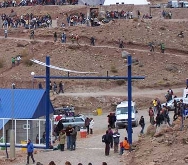 El Portal
El Portal
Los portales marcan un pasaje entre dos espacios.
En todas las culturas y latitudes, hay portales que separan "lo profano y lo sagrado". En ellos el umbral busca marcar un cambio de estado interno en quien lo atraviesa. Así sucede con los torii de los santuarios shinto japoneses, con el ingreso a mezquitas, iglesias, sinagogas; con las toranas de entrada a las estupas budistas, con algunas "puertas" en terrenos ceremoniales de los pueblos originarios de América.
Los portales del Parque están inspirados en los arcos torii de los santuarios shinto. Se levantan indicando una posibilidad; invitando a superar un límite, a atravesar el umbral para adentrarse en otros espacios y tiempos mentales.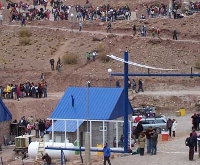 Centro de Coordinación
Centro de Coordinación
Es una de las primeras construcciones del Parque. Se usó en un principio como centro desde donde se dirigía la construcción.
Actualmente, desde "la casita" se organiza el funcionamiento del Parque y la coordinación de los servicios necesarios para las actividades.
También es el alojamiento de los amigos que se ofrecen para el cuidado del parque cuando no se están realizando actividades.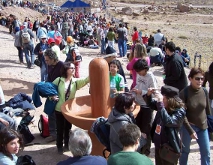 La Fuente
La Fuente
Tanto en las historias de la creación como en la mitología en general, el agua simboliza la sustancia primordial de la que nacen y a la que vuelven todas las formas. Tradicionalmente está relacionada con lo femenino y la fecundidad.
Por contigüidad, muchos pueblos han considerado sagrados a manantiales y fuentes, que en el caso de los jardines islámicos han ocupado un lugar central, reproduciendo los Jardines del Edén.
Las fuentes de los parques se inspiran en las formas del yoni-lingam de la India, que representa la unión sexual femenina y masculina. El Tantra ve en el yoni-lingam la representación suprema de lo que hay de Dios en nosotros, de la energía creativa que se manifiesta en el pensamiento y en la capacidad de crear vida.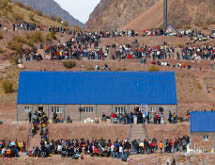 Salón Multiuso
Salón Multiuso
Es un espacio modular abierto a grupos e instituciones para la realización de eventos como seminarios, talleres, fiestas, y en general, encuentros de intercambio.
Es también un lugar amable para descansar y reponer fuerzas con una comida sencilla.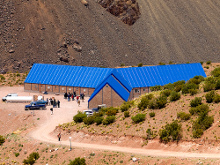 Centro de Estudio
Centro de Estudio
Es un lugar de retiro y de estudio. Desde aquí difunde Silo su Mensaje y experiencia; y las Maestras y Maestros de la Escuela investigan, reflexionan y producen contribuciones útiles para la superación del sufrimiento.
Reproduciendo la convergencia de los tres cordones montañosos y ríos donde está emplazado el Parque, el edificio del Centro de Estudios tiene tres brazos. En la planta baja hay 24 habitaciones con baños, una sala central con biblioteca y mesas destinadas al estudio e intercambio. El piso superior cuenta con siete salas de reunión, una sala de edición de audio y vídeo, y un microcine.
Separados del edificio están el área de servicio y un taller equipado para las prácticas de los Oficios: conservación y producción del fuego, prácticas con materiales en frío y moldes, y trabajos con cerámica, metales y vidrio.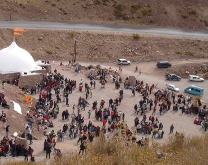 La Plaza de las Estelas
La Plaza de las Estelas
En distintas latitudes y momentos históricos las estelas, testimoniaron acontecimientos históricos significativos para la época en las que fueron construidas. Así encontramos, por ejemplo, las estelas mesopotámicas, egipcias, sumerias o de los indios mayas.
En los parques del Mensaje las estelas habitualmente contienen los nombres -grabados en chapas de acero inoxidable- de las personas que contribuyeron para la construcción del parque.
En el caso de este Parque, las estelas están grabadas con las palabras de Silo, del 4 de mayo de 1969, en las siete principales lenguas del mundo: español, inglés, ruso, chino, hindi, árabe y hebreo.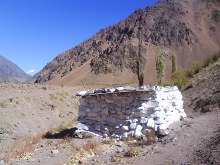 La Ermita
La Ermita
Es una pequeña construcción utilizada por Silo durante varios meses, antes de lanzar al mundo su primera arenga en 1969.
(Ver Actividades > Encuentros - 4 de mayo de 1969: "La Curación del Sufrimiento").
Originalmente estaba al otro lado del río. En 2007 fue trasladada piedra por piedra, y reconstruida fielmente donde hoy se encuentra.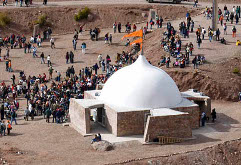 La Sala de Meditación
La Sala de Meditación
La Sala de Meditación
Desde sus orígenes, el ser humano ha buscado o construido recintos donde fuera posible conectar con una realidad superior. Así, diversas culturas usaron claros del bosque, cuevas en la montaña e islas, con ese carácter de lugares sagrados.
Construcciones redondeadas, mandórlicas, aterrazadas, rematadas con cúpulas, con conos, con agujas, con minaretes. Entre ellas se encuentran las grandes "stupas" de forma semiesférica rematadas en un conoide, hoy diseminadas por la India y otros países del Asia.
La Sala está inspirada en ellas; pero mientras son lugares cerrados e inaccesibles, nuestras salas son abiertas, vacías y sin íconos, imágenes o símbolos. Un lugar dispuesto para ser "llenado" por las personas.
Externamente, se busca llevar los ojos hacia arriba sin interrupciones. Interiormente, es un espacio semiesférico vacío, en el cual se ubica la gente de un modo circular y concéntrico, todos al mismo nivel. La forma esférica de la sala lleva a sentirse incluido en ella y a experimentar una conexión profunda con uno mismo.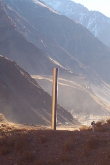 Monolito
Monolito
Se incluye entre las formas que desde antiguo fueron llamadas "ejes del mundo" por conectar el cielo y la tierra.
En la literatura de distintos pueblos, escaleras, lianas, montañas y árboles son formas de acceder al cielo. Así lo relatan varios cuentos infantiles, como también la historia del Mago Merlín, cuya sabiduría se nutría del roble; o la de Jacob, que en sueños vio la escala por la que los ángeles subían y bajaban del cielo. También los obeliscos egipcios, símbolo de los rayos de su dios solar, cumplían esa función.
En cada parque del Mensaje un monolito de acero inoxidable fija las coordenadas espacio-temporales en las que ese parque fue creado.
En este Parque histórico de Punta de Vacas, la inscripción 1969-1999 recuerda la primera aparición pública de Silo en el mismo lugar en que hoy vemos emplazado este monolito, y la fundación del parque 30 años después, al celebrarse el trigésimo aniversario del Movimiento Humanista. El Mirador
El Mirador
Está ubicado en el Monte Sacro, en el punto más elevado del Parque, permitiendo una visión amplia de todo el complejo y del imponente paisaje que lo circunda.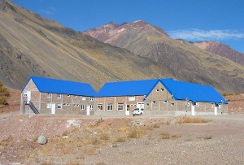 Centro de Trabajo
Centro de Trabajo
Es un ámbito donde se desarrollan retiros y jornadas de trabajo personal. Para el uso de aprendices, postulantes a Escuela, miembros del Movimiento Humanista y miembros de El Mensaje de Silo.
Es un conjunto de construcciones consistente en un salón de dos plantas, con cocina y baños. Allí pueden realizarse reuniones y actividades para conjuntos de unas 100 personas, también posee conexión a internet y elementos para proyecciones de vídeo.
Dos construcciones laterales proveen en diez departamentos, con cocina y baño, albergue para 52 personas.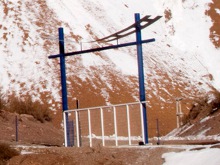 El Portal
El Portal
Marca el límite entre la externalidad del mundo y la interioridad del ser humano, buscando producir un cambio en el estado interno de todo aquel que entra a este lugar.
Los portales del Parque están inspirados en los arcos torii de los santuarios shinto. Se levantan indicando una posibilidad; invitando a superar un límite, a atravesar el umbral para adentrarse en otros espacios y tiempos mentales.